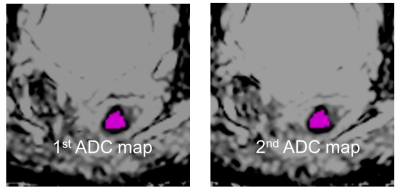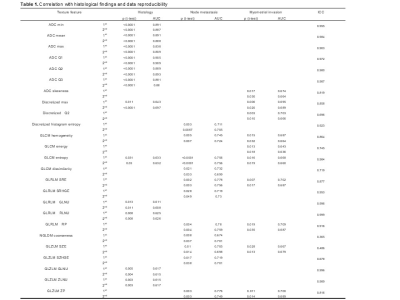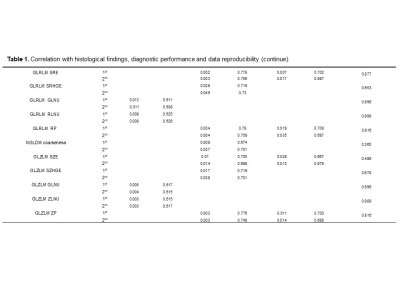3876
Some texture features from ADC map show both significance with histological findings and good reproducibility in uterine endometrial lesions1Diagnostic Radiology, Sapporo Medical University, Sapporo, Japan
Synopsis
Some texture features from ADC map show both significant correlation with histology (benign vs. malignant), lymph node metastasis and myometrial invasion (<1/2 vs. >1/2), acceptable AUC (>0.7) and high data reproducibility (ICC>0.8) in uterine endometrial lesions.
INTRODUCTION
Texture features from PET, CT and MRI have been increasingly investigated recently and shown significant correlation with histological findings and clinical outcome. The reliability of them, however, has not been performed sufficiently in clinical studies. This study was performed to evaluate a correlation between texture features extracted form ADC map and histological findings as well as its reproducibility in uterine endometrial lesions.METHODS
Total 943 patients underwent hysterectomy between June 2017 and April 2020 in our institute. Of them, 283 patients were not treated with neoadjuvant therapy and histologically diagnosed as uterine endometrial lesions. The 164 patients underwent pelvic MRI in our institute and 133 patients were examined by 3T MRI unit. After excluding 4 patients, different DWI sequences 2, lack of DWI 1 and no detectable lesion 1, remaining 129 patients (benign: 36, malignant: 93) were analyzed. Of them, 52 patients underwent two sets of sequential DWIs after informed consent. Texture features were extracted by using LIFEx 6.20 (1). Region of interest was assigned on the ADC map generated form DWIs with b-values of 0 and 1000 s/mm2 covering uterine endometrial lesion with referring to other sequences by two radiologists. In case of disagreement, a consensus was reached through discussion. For the cases with two repeated DWIs, the same ROI was assigned for the 1st and 2nd ADC maps holding its size and location. Representative case was demonstrated in Fig. 1. The association between texture metrics and histology (benign vs. malignant), lymph node metastasis and myometrial invasion (<1/2 vs. >1/2) was analyzed using t-test for the 1st ADC map of those underwent DWIs twice (52 cases) and for the ADC map with DWI once (77 cases), and for the 2nd ADC map of those underwent DWIs twice (52 cases) and for the ADC amp with DWI once (77 cases). ROC analysis was done for the metrics with significance in t-test. As for data reproducibility, ICC was analyzed for two sets of ADC maps of 52 cases. P<0.05 was considered to be statistically significant. AUC>0.7 and ICC >0.8 was considered acceptable in clinical application.RESULTS
As for histology, ADC minimum and mean and max and Q1 and Q2 and Q3, discretized max, GLCM entropy, GLRLM GLNU and RLNU, and GLZLM GLNU and ZLNU showed significance, and ADC Q1 was the best with AUC of 0.905 and 0.909 for the 1st and 2nd ADC maps, respectively and ICC of 0.972. In lymph node metastasis, Discretized histogram entropy, GLCM homogeneity and entropy and dissimilarity, GLRLM SRE and SRHGE and RP, NGLDM coarseness, and GLZLM SZE and SZHGE and ZP showed significance, and Discretized histogram entropy (AUC of 0.711 and 0.705, ICC of 0.923), GLCM homogeneity (AUC of 0.745 and 0.724, ICC of 0.864) and entropy (AUC of 0.756 and 0.756, ICC of 0.984), GLRLM SRE (AUC of 0.778 and 0.756, ICC of 0.877) and SRHGE (AUC of 0.719 and 0.73, ICC of 0.953) and RP (AUC of 0.78 and 0.759, ICC of 0.916), and GLZLM ZP (AUC of 0.776 and 0.749, ICC of 0.816) demonstrated acceptable performance. As for myometrial invasion (<1/2 vs. >1/2), ADC skewness, Discretized max and Q2, GLCM homogeneity and energy and entropy, GLRLM SRE and RP, GLZLM SZE and ZP demonstrated significance but no metrics showed acceptable performance of AUC > 0.7 in both 1st and 2nd ADC maps. GLCM entropy showed significance in all factors, histology, lymph node metastasis, and myometrial invasion. Results were summarized in Table 1.DISCUSSION
To our knowledge, this would be the first report demonstrating both significant correlation between texture features extracted from ADC map and histological findings, good diagnostic performance and data reproducibility in uterine endometrial lesions. Several studies have been performed to analyze correlation between texture features from ADC map, and histological factors and prognosis in uterine endometrial lesions but the results differed. Ytre-Hauge S et al. reported that ADC entropy is associated with myometrial invasion but not in our study (2). Yamada I et al. reported that 11 features were correlated with recurrence by using random forest model and tree metrics, GLRLM SRHGE, and GLZLM SZHGE and SZE also showed significance in lymph node metastasis in our study (3). However, GLZLM SZHGE did not satisfy acceptable reproducibility with ICC>0.8. As many texture features could be extracted from ADC map compared to the number of cases, there always is a possibility of resulting in incidental significance. We consider that assuring data reproducibility as well would be necessary before applying results to clinical practice.CONCLUSION
Some texture features show both significant correlation with histological findings, and acceptable AUC and reproducibility in uterine endometrial lesions, could be applied for clinical use.Acknowledgements
No acknowledgement found.References
1. Nioche C, Orlhac F, Boughdad S, Reuze S, Goya-Outi J, Robert C, et al. LIFEx: A Freeware for Radiomic Feature Calculation in Multimodality Imaging to Accelerate Advances in the Characterization of Tumor Heterogeneity. Cancer Res. 2018;78(16):4786-9.
2. Ytre-Hauge S, Dybvik JA, Lundervold A, Salvesen OO, Krakstad C, Fasmer KE, et al. Preoperative tumor texture analysis on MRI predicts high-risk disease and reduced survival in endometrial cancer. Journal of Magnetic Resonance Imaging. 2018;48(6):1637-47.
3. Yamada I, Miyasaka N, Kobayashi D, Wakana K, Oshima N, Wakabayashi A, et al. Endometrial Carcinoma: Texture Analysis of Apparent Diffusion Coefficient Maps and Its Correlation with Histopathologic Findings and Prognosis. Radiology: Imaging Cancer. 2019;1(2).
Figures


